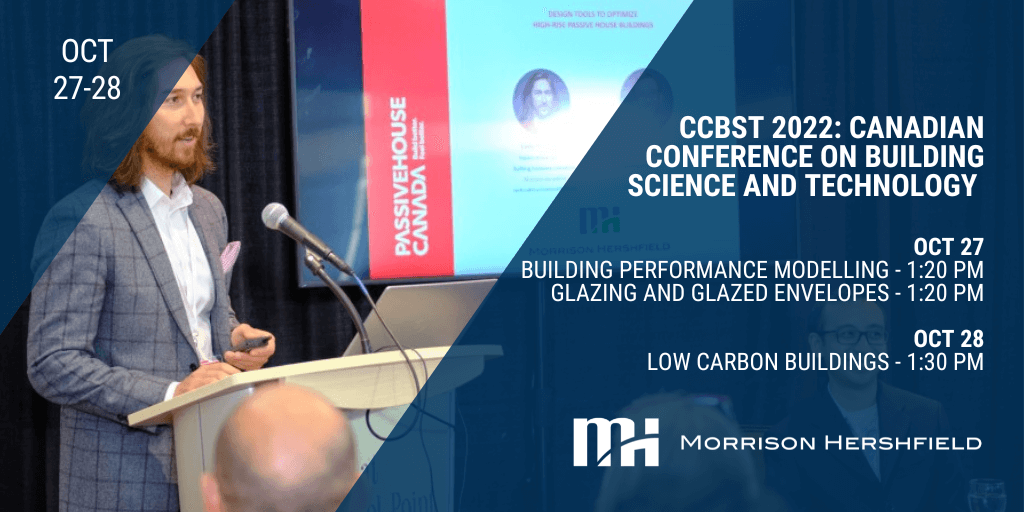
- This event has passed.
CCBST 2022: Canadian Conference on Building Science and Technology
October 27, 2022 - October 28, 2022

The CCBST 2022 conference’s theme is constructing today’s buildings for tomorrow. Join the discussion to learn how we can design, maintain, and operate our buildings in ways that lead to healthier indoor environments and reduced impact on the natural environment by using new and innovative materials, construction techniques, and ways of thinking. Join us on October 27 – 28, 2022.
More information and registration.
Session Overview: Building Performance Modelling
The Role of Thermal and Hygrothermal Modelling in Deep Energy Retrofit of Heritage Buildings
This paper discusses the role of thermal and hygrothermal simulations in improving the thermal performance and durability of building envelope upgrades for heritage masonry buildings and presents an approach where to effectively use these models. The approach includes the use of 3D thermal analysis to evaluate thermal bridging at critical details including window to wall details, intermediate floor, and parapets. Results from these models provide a better understanding of the complex heat flow paths leading to more effective thermal bridging mitigation strategies including the use of innovative materials such as aerogel insulation. 1D and 2D hygrothermal analysis was used to evaluate heat and moisture flow of existing and retrofit wall assemblies to better assess the risk of freeze-thaw damage. The analysis evaluated wall sections that included stone masonry and mortar joints. Findings from the thermal and hygrothermal analysis help guide designers in developing appropriate design options to reduce the carbon emission of the heritage building. These design options can then be evaluated in whole building energy models to better quantify energy consumption and carbon emissions reductions.
Ivan Lee will present at 1:20 pm – 2:30 pm | Room: Pretium Room | Session Chair: Negar Pakzadian
Session Overview: Glazing and Glazed Envelopes
Quality in Fenestration Systems: An Alphabet Soup of Compliance Standards is Not Enough
The need to demonstrate fiscal responsibility for building projects typically drives owners, construction managers and general contractors to consider cost savings available through the global supply chain. Global procurement is often relied upon for curtain wall, window wall and other fenestration systems and components. Although global procurement has its opportunities and risks, the financial advantages can be considerable. Ensuring acceptable quality offshore products is not just a matter of writing into a specification a requirement to comply with applicable building codes, standards and industry practice documents. In terms of global procurement, free-trade agreements requirements may also create limits. Technical documents contain surprising limitations and omissions so that despite best efforts, a Quality Assurance (QA) plan and Quality Control (QC) program may not achieve the desired quality outcome. Even if initial product quality samples and production are correct, quality may diminish over time, an effect known as Quality Fade (QF). To be fair, QA, QC and QF can be an issue with domestic producers also. The same latitude in industry practices and standards available to offshore suppliers is, of course, available to domestic suppliers. So, whether or not fenestration systems are globally or locally procured, the building owners, the design team and the construction team. should be aware of omissions and limitations of industry practices and standards to avoid unexpected surprises too late in the construction process to make changes. Well-developed QA plan and QC programs, implemented from design through bidding and into the construction phases can be instrumental to attaining the intended quality level.
Anik Teasdale-St-Hilaire will present at 1:20 pm – 2:30 pm | Room: Sinatra | Session Chair: Rachel Smith
Session Overview: Low Carbon Buildings
Design Tools to Optimize High-Rise Passive House Buildings
The study demonstrates how optimizing high impact thermal bridges at window-to-wall transitions can have a significant impact to the space heating/cooling demand, primary energy renewable (PER) demand, and overall building enclosure design. If planned early in design, optimized high impact thermal bridge values can be an effective strategy to reduce wall thickness, reduce embodied carbon emissions, meet low energy demand targets, and potentially provide cost-effective solutions for the Developer/Owner. Whole-building energy simulations used in combination with three-dimensional (3-D) and two-dimensional (2-D) thermal simulations of high impact thermal bridges enhance its purpose as an optimization tool to reduce operational and embodied carbon emissions, empowering Passive House Consultants/Designers to harness the power of PHPP to make better informed design decisions. When this strategy is combined with low embodied carbon materials and 100% electrification for operational energy, we will effectively transition Passive House buildings into the sustainable buildings we strive for.
Cody Belton will present at 1:30 pm – 2:50 pm | Room: Sinatra | Session Chair: Mila Aleksic.